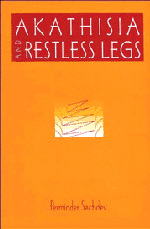Book contents
- Frontmatter
- Contents
- Foreword
- Acknowledgements
- Abbreviations
- Part I Introduction
- Part II Drug-induced akathisia
- Part III Restless legs syndrome
- 12 Restless legs syndrome: clinical features and pathophysiology
- 13 Treatment of restless legs syndrome
- Part IV Conclusions
- Appendix A Haskovec's Akathisie
- Appendix B Prince Henry Hospital Akathisia Scale
- Appendix C Barnes (1989) Akathisia Rating Scale
- Appendix D Hillside Akathisia Scale (version 4)
- References
- Index
13 - Treatment of restless legs syndrome
from Part III - Restless legs syndrome
Published online by Cambridge University Press: 12 September 2009
- Frontmatter
- Contents
- Foreword
- Acknowledgements
- Abbreviations
- Part I Introduction
- Part II Drug-induced akathisia
- Part III Restless legs syndrome
- 12 Restless legs syndrome: clinical features and pathophysiology
- 13 Treatment of restless legs syndrome
- Part IV Conclusions
- Appendix A Haskovec's Akathisie
- Appendix B Prince Henry Hospital Akathisia Scale
- Appendix C Barnes (1989) Akathisia Rating Scale
- Appendix D Hillside Akathisia Scale (version 4)
- References
- Index
Summary
An interesting array of drugs and other therapies has been used in the treatment of RLS. An early aetiological hypothesis that guided much treatment was that the symptoms were due to the accumulation of metabolites caused by reduced blood flow at rest. Ekbom (1960) recommended the use of peripheral vasodilators like tolazoline and carbachol, suggesting that they ameliorated symptoms in two-thirds of patients. Other drugs reported to have good results included meso-inositol hexanicotinate and nitroglycerine (Allison, 1943). These drugs are no longer used in the treatment of RLS, and one questions the earlier results as possibly placebo effects. Other substances recommended in the literature include ascorbic acid (Swedberg, 1952), aldehydes (Brenning, 1957), dextran (Nordlander, 1953), heparin and quinine (Bornstein, 1961). Nonspecific methods like massage or the use of vibration and the administration of sedative-hypnotics and analgesics were recommended by Ekbom (1960). Unilateral lumbar sympathectomy was unsuccessful in one case (Ekbom, 1960).
In patients with iron deficiency anaemia, Ekbom (1960) reported good results with iron injections. Iron therapy was also recommended for those without anaemia or other evidence of iron deficiency (Nordlander, 1953), but no empirical evidence was presented to support this. Roger et al (1991) studied the effect of epoetin (Exprex, Janssen-Cilag), used for the correction of anaemia in uraemic patients on chronic renal dialysis. They gave 40 units/kg iv three times a week titrated to maintain haemoglobin between 90 and 100 g/l.
- Type
- Chapter
- Information
- Akathisia and Restless Legs , pp. 326 - 342Publisher: Cambridge University PressPrint publication year: 1995



